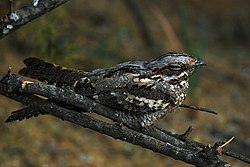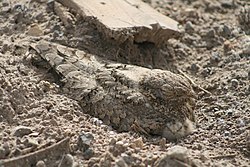| Caprimulgus | |
|---|---|
 | |
| Large-tailed nightjar (Caprimulgus macrurus) | |
| Scientific classification | |
| Kingdom: | Animalia |
| Phylum: | Chordata |
| Class: | Aves |
| Clade: | Strisores |
| Order: | Caprimulgiformes |
| Family: | Caprimulgidae |
| Genus: | Caprimulgus Linnaeus, 1758 |
| Type species | |
| Caprimulgus europaeus (European nightjar) Linnaeus, 1758 | |
| Species | |
39, see text. | |
| Synonyms | |
Stenopsis | |
Caprimulgus is a large and very widespread genus of nightjars, medium-sized nocturnal birds with long pointed wings, short legs and short bills. Caprimulgus is derived from the Latin capra, "nanny goat", and mulgere, "to milk", referring to an old myth that nightjars suck milk from goats. The common name "nightjar", first recorded in 1630, refers to the nocturnal habits of the bird, the second part of the name deriving from the distinctive churring song. [1]
Contents
Caprimulgus nightjars are found around Afro-Eurasia and Australasia, and like other nightjars they usually nest on the ground. They are mostly active in the late evening and early morning or at night, and feed predominantly on moths and other large flying insects.
Most have small feet, of little use for walking, and their soft plumage is cryptically coloured to resemble bark or leaves. Some species, unusually for birds, perch along a branch, rather than across it, which helps to conceal them during the day. Temperate species are strongly migratory, wintering in the tropics.
Caprimulgus species have relatively long bills and rictal bristles. Many have repetitive and often mechanical songs.





































